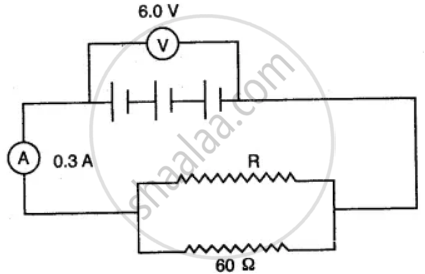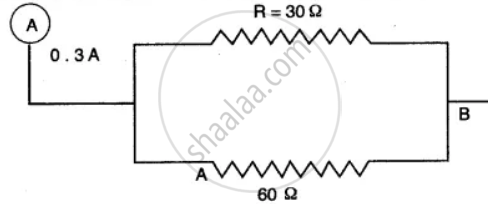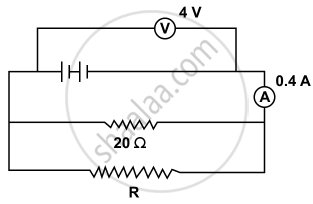Advertisements
Advertisements
प्रश्न
In the figure below, the ammeter A reads 0.3 A. Calculate:
(i) the total resistance of the circuit
(ii) the value of R
(iii) the current flowing through R.

उत्तर
(i) ∵ V = IR
∴ R = `"V"/"I" = 6.0/0.3 = 20 Ω`
(ii) Total resistance = 20 Ω
∵ Resistance in parallel
∴ `1/20 = 1/"R" + 1/60`
`1/"R" = 1/20 - 1/60`
`1/"R" = (3 - 1)/60`
R = `60/2 = 30 `Ω
(iii) ∵ V = IR
and potential (V) is equal at the two ends i.e. A and B

Let I1 be current flowing through R
∴ (0.3 - I1) is current flowing through 60 Ω resistance.
Now V = V ⇒ I1R1 = I2R2
I1 × 30 = (0.3 - I1) × 60
I1 = 0.6 - 2I1
3I1 = 0.6
I1 = `0.6/3 = 0.2`
∴ Current flowing through R = 0.2 A
APPEARS IN
संबंधित प्रश्न
How can three resistors of resistances 2 Ω, 3 Ω and 6 Ω be connected to give a total resistance of 4 Ω ?
State the law of combination of resistances in parallel.
A wire that has resistance R is cut into two equal pieces. The two parts are joined in parallel. What is the resistance of the combination?
Explain with diagram what is meant by the "series combination" and "parallel combination" of resistances. In which case the resultant resistance is : (i) less, and (ii) more, than either of the individual resistances?
If current flows through two lamps arranged:
(a) in series,
(b) in parallel,
and the filament of one lamps breaks, what happens to the other lamp? Explain your answer.
State how are the two resistors joined with a battery when equivalent resistance is less than either of the two resistances.
State how are the two resistors joined with a battery when potential difference is same across each resistor.
In the following figure calculate:
- the total resistance of the circuit
- the value of R, and
- the current flowing in R.

How does the resistance of a metallic wire depend on the length of wire?
Two resistors of resistances 2 Ω and 3 Ω are connected in parallel to a cell to draw current 0.5 A from the cell. Draw a labelled diagram of the arrangement
